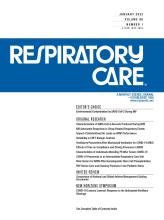The COVID-19 pandemic has taught us a lot. One vital lesson learned by the respiratory community has been differentiating the risks of aerosol transmission and the classification of aerosol-generating procedures (AGPs).
During the early pandemic, several experimental studies reported live virus from aerosols and surfaces hours after inoculation,1,2 resulting in concerns of aerosol transmission. We were reluctant to use noninvasive respiratory support such as high-flow nasal cannula (HFNC) oxygen therapy, CPAP, or noninvasive ventilation (NIV) to treat patients with COVID-19; and instead, we took an aggressive intubation strategy, which contributed to the crisis of ventilator shortage.3,4 Since then, numerous studies have been conducted to understand viral transmission via aerosols.5-11 Study types included those that indirectly quantified aerosol particle concentrations,6,7 aerosol dispersion distances and travel trajectory,8 as well as direct measurements of viruses in aerosols.9-11 To date, no studies have reported higher risks of virus transmission when HFNC, CPAP, or NIV is used compared to conventional oxygen therapy or invasive mechanical ventilation.6-11 As a result, many institutions have removed HFNC, CPAP, and NIV from their AGP list.12 Not surprisingly, these institutions have reported avoidance of intubation for patients with COVID-19 by using noninvasive respiratory support.13,14
In this issue of the Journal, 2 studies report direct evidence of viral detection during NIV and HFNC in COVID-1915,16 in which the findings further support removing them from the AGP lists. The results also suggest that clinicians can be confident in using noninvasive modalities safely. Dell’Olio15 et al investigated the presence of SARS-CoV-2 on surfaces near subjects with COVID-19 receiving NIV at 4 distances (50, 80, 150, and 200 cm). The samples were taken immediately and 6, 12, and 24 h after surface disinfection. Two-hundred fifty-six samples were collected, and none were positive for SARS-CoV-2.15 Ramsey and colleagues16 attempted different sampling methods to capture SARS-CoV-2 virus in the vicinity of 37 subjects with COVID-19 during noninvasive respiratory support, primarily HFNC. Thirty-one subjects had saliva samples tested at the time of aerosol sample collection, with 14 positive for SARS-CoV-2 RNA. Initially, the authors used vacuum pumps at a low flow (5 L/min) to capture aerosol samples at 30–45 cm in front of the subjects for 20–90 min, which collected 100–450 L of air. None of the samples were positive. Then they placed vacuum pumps at higher flows (80–90 L/min) to capture 2,500–6,000 L of air samples at 2–3 m from the subject’s bed and still did not detect any virus. They also devised a scavenger face tent to directly capture aerosol samples from the subject’s airway overnight, with a vacuum flow of 30 L/min, which collected > 10,000 L of air, with a corresponding sampling limit of detection of approximately 0.01 viral particles/L.16 At such high sensitivity and close proximity, samples from the 4 subjects using a scavenger face tent turned out to be positive. Among the 4 subjects, one had a negative saliva sample; but the aerosol sample was positive, implying that the exposure dose to infectious aerosols was very low. Both studies suggested a low risk of aerosol transmission of SARS-CoV-2 with the use of HFNC and NIV.15,16
Compared to aerosol particle concentrations generated during breathing room air, conventional oxygen therapy, HFNC, CPAP, or NIV, aerosol particle concentrations generated by coughing or sneezing are hundreds of fold higher.5,12 Bioaerosols generated by coughing or sneezing that come from airways have been shown to carry pathogens.17 Thus, procedures or treatments that provoke patients to cough or sneeze remain as a clinical concern. When patients are coughing or sneezing, they need to cover their face with a mask, tissue, or elbow. They can cough at any time during the utilization of noninvasive respiratory support. When HFNC or NIV is used, placing a surgical mask over HFNC7,8 or using dual-limb ventilators and placing filters on the exhalation ports during NIV15,16 can help significantly reduce the bioaerosol particle concentrations. Indeed, mitigation strategies were taken in these 2 studies;15,16 they also used high room ventilation and air exchanges (4–6 exchanges per hour in Ramsey et al16 and 10 exchanges per hour in Dell’Olio et al15). The results of almost no detection of the SARS-CoV-2 virus might imply that these mitigation measures are effective.15,16
Bioaerosol transmission can be interrupted by reducing the concentrations of pathogens generated at the source, impeding pathogen transportation and protecting the host.3,17 In addition to mitigating bioaerosol generation and transportation, personal protection equipment is also effective at interrupting transmission. Lastly, we should be aware that the outcome of host-viral interactions depends on the dose and route of infection, viral virulence properties, as well as several host factors that mainly involve innate and adaptive immunity.18 Vaccination helps build immunity, reducing the risk of severe illness.
Both studies were initiated during the early pandemic (April 2020),15,16 when medical facilities were overwhelmed with COVID-19 patients, especially bedside clinicians. These authors took on additional work to seek evidence of aerosol transmission and should be congratulated and appreciated for their efforts. Their findings,15,16 along with many others,5-12 demonstrate great examples of how research changes clinical practice and why such evidence is essential to the practice of evidence-based medicine. These lessons learned from the COVID-19 pandemic prepare us to better deal with future pandemics, as we know how to use available tools to optimize care for patients while protecting ourselves.
Footnotes
- Correspondence: Jie Li PhD RRT RRT-ACCS RRT-NPS FAARC, 600 S Paulina Street, Suite 765, Chicago, IL 60612. E-mail: Jie_li{at}rush.edu
See the Original Study on Page 1
Dr Li discloses relationships with The Rice Foundation, the American Association for Respiratory Care, Fisher & Paykel Healthcare Ltd, Aerogen Ltd, and Heyer Ltd. Dr Li also serves as section editor for Respiratory Care.
- Copyright © 2023 by Daedalus Enterprises







